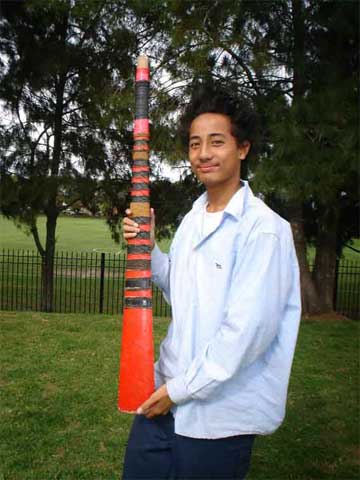Marcellin College
Fa’a Samoa: The Samoan Way
Kilikiti
by Bronson
Kilikiti is the Samoan form of cricket. It is very popular with Samoans in New Zealand. In Auckland the Secondary Schools Senior tournament is held at the Domain annually. It is the biggest kilikiti tournament in the world.
My own personal experience of kilikiti was late last year. Every year my church and many other churches have an inter-church sports day. The day includes games like volley, touch, netball and of course kilikiti.
The rules of kilikiti are similar to those of cricket except that we have 21 players and all players must “Sulu ie lavalava” or wear a sarong. The key rule is “no lavalava no play.” The “Pate” is the Samoan design of the bat. It has 2 straight sides which meet at an angle like a triangle, and one curved side which is the side we hit the ball with. The pate can vary in length. Most people use the short pate, while the more skilled players prefer the longer ones.
While the first two batters go to bat the rest of the team sit just outside the field with their many colourful pate and dance, sing and chant to encourage the batters. Every ‘au’ or team tries to come up with better cheers than the other. Their captain will make a great effort to do so and will sometimes take his lavalava off and wave it around, or even climb a tree and shake it vigorously.
If you think the malae te’a or fielders are just going take that, then think again. They too have their leader who leads them into hilarious actions with a whistle. These actions can reflect people when they are drunk or even in the toilet. It can all get very earthy! Sometimes if the lape gets too offensive fights may start. But this is the exception rather than the rule. Mostly it’s just a lot of fun.
Kilikiti evolved from the game of cricket which the English missionaries bought to Samoa many years ago. The Samoans adopted the game but gave it their own twist and renamed it as kirikiti. The change of name happened because Samoans couldn't pronounce the English word cricket properly so they called it kirikiti. Later on the pronunciation of the letter 'r' changed to 'l' in the Samoan language so then the name changed to kilikiti. We usually use the word kilikiti now but the older word kirikiti is still used during formal occasions.
Over the years kilikiti has become a well-known sport in the Pacific and has spread to countries like Fiji, Tokelau, Tuvalu and Tonga. I’ll finish this story with how we Samoans say it:
“Manuia le ta, manuia le Te’a. Luck to the bat, luck to the ball.

